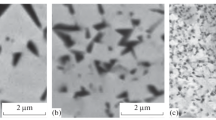Abstract
The experimental dependences of strength, plastic properties, hardness, and fracture toughness on sintering or pressing temperature for ultrafine alloy WC-41 wt.% Co are presented. The alloy densifies in solid phase and temperature varies from 950 to 1250°C. The dependences of mechanical properties are extreme, excepting fracture toughness. The properties reach their maximum values at 1050 to 1150°C depending on the type of testing. Fracture toughness continuously increases with densification temperature. The highest values of some properties are reached after additional solid-phase annealing. The mechanical properties of ultrafine high-cobalt alloy samples are assessed with the use of structural parameters and empirical equations established for standard hard WC-Co alloys sintered in liquid phase. The calculated and experimental values of properties differ: transverse rupture strength, fracture toughness, and yield strength show higher values, while hardness and compressive strength have lower values as compared with calculated ones.
Similar content being viewed by others
References
A. I. Tolochin, A. V. Laptev, M. E. Golovkova, and M. S. Koval’chenko, “Ultrafine high-cobalt VK40 hard alloy. I. Structure and properties,” Powder Metall. Met. Ceram., 47, No. 3–4, 27–36 (2008).
J. Gurland and J. T. Norton, “Role of binder in binder phase in hard alloys,” in: High-Temperature Oxidation-Resistant and Corrosion-Resistant Metal Ceramics, Oborongiz, Moscow (1959), pp. 109–120.
J. L. Chermant, A. Deschanvres, and F. Osterstock, “Factor influencing the rupture stress of hardmetals,” Powder. Met., 20, No. 2, 63–69 (1977).
V. A. Ivensen, “Connection of the mechanical properties of hard alloys with production modes and strength of these alloys,” in: Proc. 3rd Int. Conf. Powder Metallurgy, Vol. III, Book 4, Karlovy Vary, Czech Republic (1970), pp. 64–73.
I. L. Chermant and F. Osterstock, “Fracture toughness and fracture of WC-Co composites,” J. Mat. Sci., 11, No. 12, 1939–1951 (1976).
M. G. Loshak, Strength and Durability of Hard Alloys [in Russian], Naukova Dumka, Kiev (1984), p. 328.
M. Slesar, I. Dusza, and L. Parilak, “Micromechanics of fracture in WC-Co hardmetals,” in: 2nd Int. Conf. Science Hard Materials, Rhodes (1984) (Bristol, Boston (1986)), pp. 657–668.
D. Bolton and R. Keely, “Effects of non-stoichiometric carbon contents on the fracture toughness of WC-Co hard material alloys,” in: Int. J. of Refractory Metals & Hard Materials, 1, No. 3, 103–114 (1982).
V. F. Ochkasov, “Fracture toughness of hard WC-Co alloys,” in: Research of Hard Alloys [in Russian] (Collection of VNIITS Scientific Papers), Metallurgiya, Moscow (1991), pp. 16–21.
I. N. Chaporova and K. S. Chernyavskii, Structure of Hard Sintered Alloys [in Russian], Metallurgiya, Moscow (1975), p. 248.
A. V. Laptev, S. S. Ponomarev, and L. F. Ochkas, “Study of possibility of solid phase producing poreless WC-26% Co hard metal at high energy pressing,” in: Proc. EURO PM’99 Conf. on Advances in Hard Materials Production (November 8–10, Turin, Italy), Turin (1999), pp. 205–212.
M. T. Laugier, “Coercivity, hardness and microstructure in WC-Co composites,” J. Mater. Sci. Lett., 4, 211–216 (1985).
A. Merts, “Modern explanation for the connection of microstructure with the mechanical properties of sintered materials by the example of hard alloys,” Powder Metallurgy, Visshaya Shkola, Minsk (1977), pp. 129–134.
A. G. Evans and T. R. Wilshaw, “Quasi-static solid particle damage in brittle solids,” Acta Met., 24, 939–945 (1976).
G. S. Kreimer, Strength of Hard Alloys [in Russian], Metallurgiya, Moscow (1971), p. 247.
V. A. Ivensen, O. N. Éiduk, and V. A. Chistyakova, “Dependence of the yield strength of WC-Co hard alloys on their cobalt content and tungsten carbide grain size,” Powder Metall. Met. Ceram., 13, No. 5, 413–415 (1974).
K. S. Chernyavskii, Stereology in Materials Science [in Russian], Metallurigya, Moscow (1977), p. 280.
H. Doi, Elastic and Plastic Properties of WC-Co Composite Alloys, Tel-Aviv, Israel (1974), p. 109.
Author information
Authors and Affiliations
Corresponding author
Additional information
__________
Translated from Poroshkovaya Metallurgiya, Vol. 47, No. 5–6 (461), pp. 66–76, 2008.
Rights and permissions
About this article
Cite this article
Tolochin, A.I., Laptev, A.V., Golovkova, M.E. et al. Ultrafine high-cobalt hard alloys. II. Connection between mechanical properties and structure. Powder Metall Met Ceram 47, 316–323 (2008). https://doi.org/10.1007/s11106-008-9022-6
Received:
Published:
Issue Date:
DOI: https://doi.org/10.1007/s11106-008-9022-6




